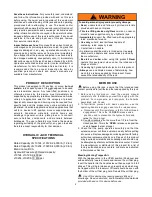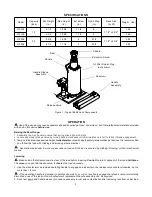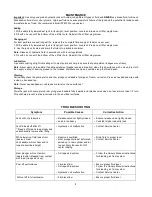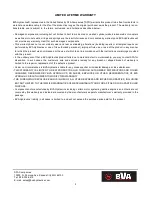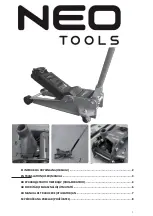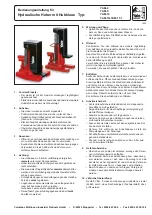
3
Model
Capacity
(tons)
Min. Height
(in.)
Max. Height
(in)
Ext. Screw
(in)
Hyd. Lifting
(in)
Base Size
(L x W)
Weight (lbs)
J10124
9 1/2
18 5/8
3 1/8
6
19.6
J10126
6 1/8
10 5/8
1 1/2
3
16.5
J10204
9 5/8
18 3/4
4
5 1/8
29.3
J10206
6 1/2
11 1/4
2
2 3/4
22.2
12
20
7 1/2" x 4 5/8"
7 1/2" x 5 3/8"
!
!
SPECIFICATION
S
Figure 1 - Typical Bottle Jack Components
Handle
Assembly
Saddle
Handle Sleeve
Assembly
Handle
Oil Filler Screw/ Plug
(not shown)
Release Valve
Extension Screw
Ram
Reservoir
OPERATION
Use of this device may require special skills and knowledge. Read, understand, and follow
all
printed materials provided
with and on this device
before use
.
Raising the Ram Plunger
1. Assemble the 3-pc handle, ensure that spring clips align with slots.
2. Locate and close release valve by turning handle clockwise until firm resistance is felt to further thread engagement.
3. Pump until load reaches desired height.
Immediately
secure with appropriately rated mechanical devices. It is recommended
you follow the load with cribbing and blocking where practical.
Never allow personnel to work or pass under a load until the load is secured by cribbing, blocking, or other mechanical
means.
Lowering
Make certain that all personnel are clear of the load before lowering.
Control
the rate of descent of the load
at all times
.
The
more
you open the release valve, the
faster
the load descends.
1. Use the manufacturer's provided operating handle to engage and slowly turn the release valve counter-clockwise, but no
more than 1/2 turn.
If the operating handle is damaged, operates abnormally, or will not positively engage the release valve, immediately
discontinue use of the jack until a manufacturer's replacement handle assembly can be acquired.
2. Push ram down and handle sleeve in to reduce exposure to rust and contamination after removing jack from under load.
!
!


